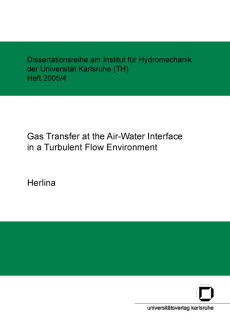Herlina
Gas transfer at the air-water interface in a turbulent flow environment
Reihe: Dissertationsreihe am Institut für Hydromechanik der Universität Karlsruhe (TH)The gas transfer process across the air-water interface in a ottom-shear-induced turbulent environment was investigated to gain improved fundamental understanding of the physical mechanisms that control the process. For this purpose, it is necessary to reveal the hydrodynamics of the flow field as well as the molecular diffusion and the turbulent transport contributions to the total flux. Therefore, detailed laboratory experiments were conducted to obtain these information. The experiments were performed in a grid-stirred tank using a combined Particle Image Velocimetry – Laser Induced Fluorescence (PIV-LIF) technique that has been developed for these near surface gas transfer measurements. The turbulence characteristics of the velocity near the interface were acquired from the PIV measurements and showed generally good agreement with the theoretical profiles from Hunt & Graham (1978). The LIF technique enabled visualization of the planar concentration fields which provided more insight into the gas transfer mechanisms. The high data resolution allowed detailed quantification of the concentration distribution within the thin aqueous boundary layer. The mean and turbulent fluctuation characteristics of the concentration could be elucidated and the molecular diffusion contribution to the total flux across the interface could be determined. With the combined PIV-LIF technique, which enables simultaneous and spatially synoptic measurements of 2D velocity and concentration fields, the turbulent mass flux term cw and also the total mass flux across the air-water interface could be quantified directly. For the first time, a particular trend can be inferred from the measured mean cw profiles. It could also be shown that the contribution of the turbulent mass flux to the total gas flux is significant. The co-spectra indicated different behavior for the cases with lower and higher turbulent Reynolds numbers. The interrelated interpretation of the obtained results suggest that the gas transfer process is controlled by a spectrum of different eddy sizes and the gas transfer at different turbulence levels can be associated to certain eddy sizes. For high turbulence levels the gas transfer should be asymptotic to the small eddy model, whereas for low turbulence level to the large eddy model. The new results of turbulent mass flux should aid as an excellent database in refining numerical models and developing more accurate models for the prediction of the transfer velocity.

